An investigation into learners’ attitudes towards training metacognitive strategies in reading comprehension
Training metacognitive strategies to enhance English reading comprehension have been
conducted around the world since 1990s. However, in Vietnam, there is a lack of research
investigating learners’ attitudes towards applying a specific model of metacognitive strategy
instructions in reading, which contributes clearly to the success of teaching metacognitive
strategies. This work aims to investigate learners’ attitudes towards explicit integration of
metacognitive strategies in reading. To this aim, a descriptive inquiry method was employed with
102 non-English major participants at the University of People’s Security. The main research tool
used was an attitudinal questionnaire. The findings of this study indicated that the employment of
an explicit strategy training model in teaching metacognitive strategies received positive attitudes
from most of the participants. In addition, there was a statistical difference between the attitudes of
learners with high-level and those with low-level reading proficiency.
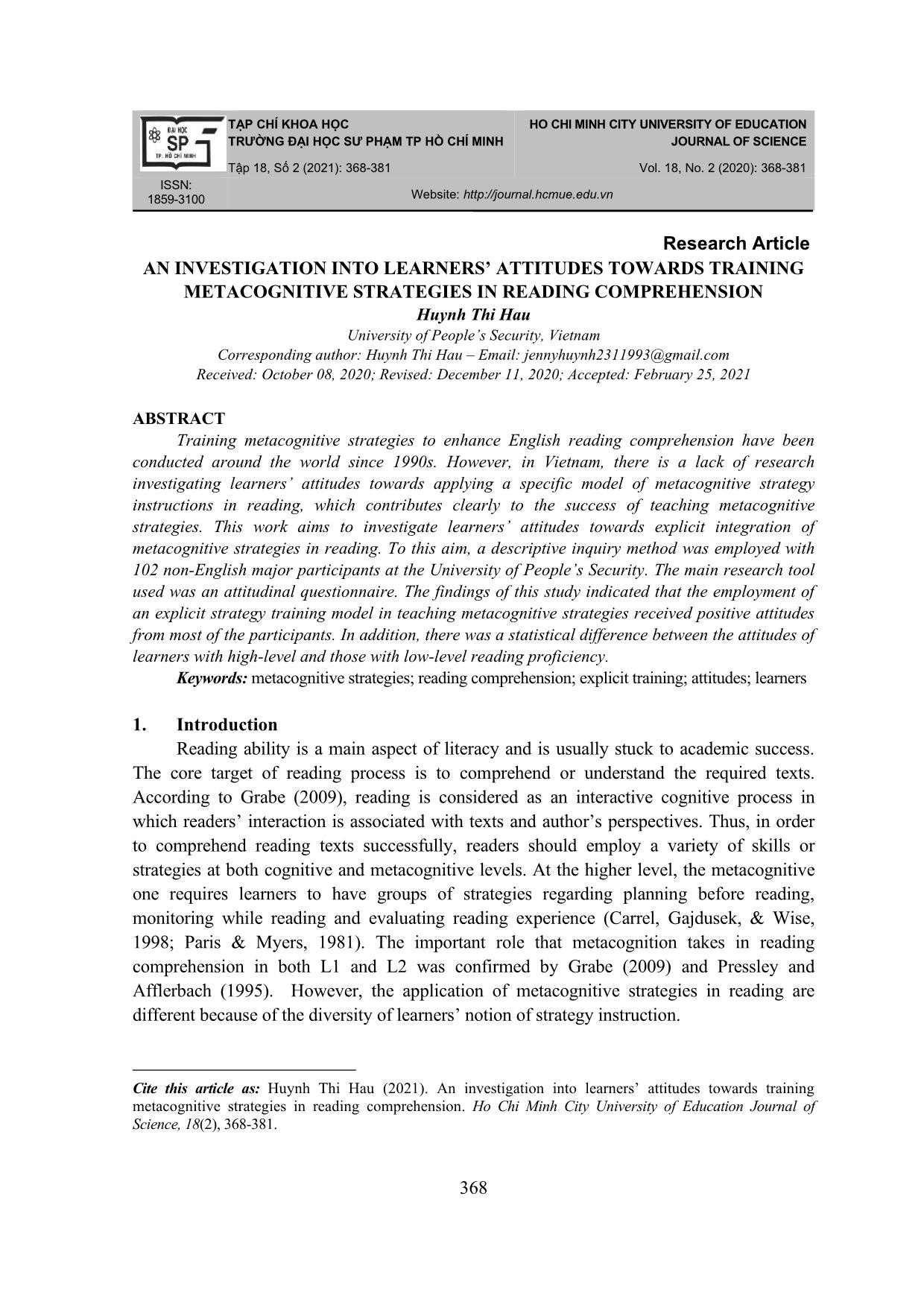
Trang 1
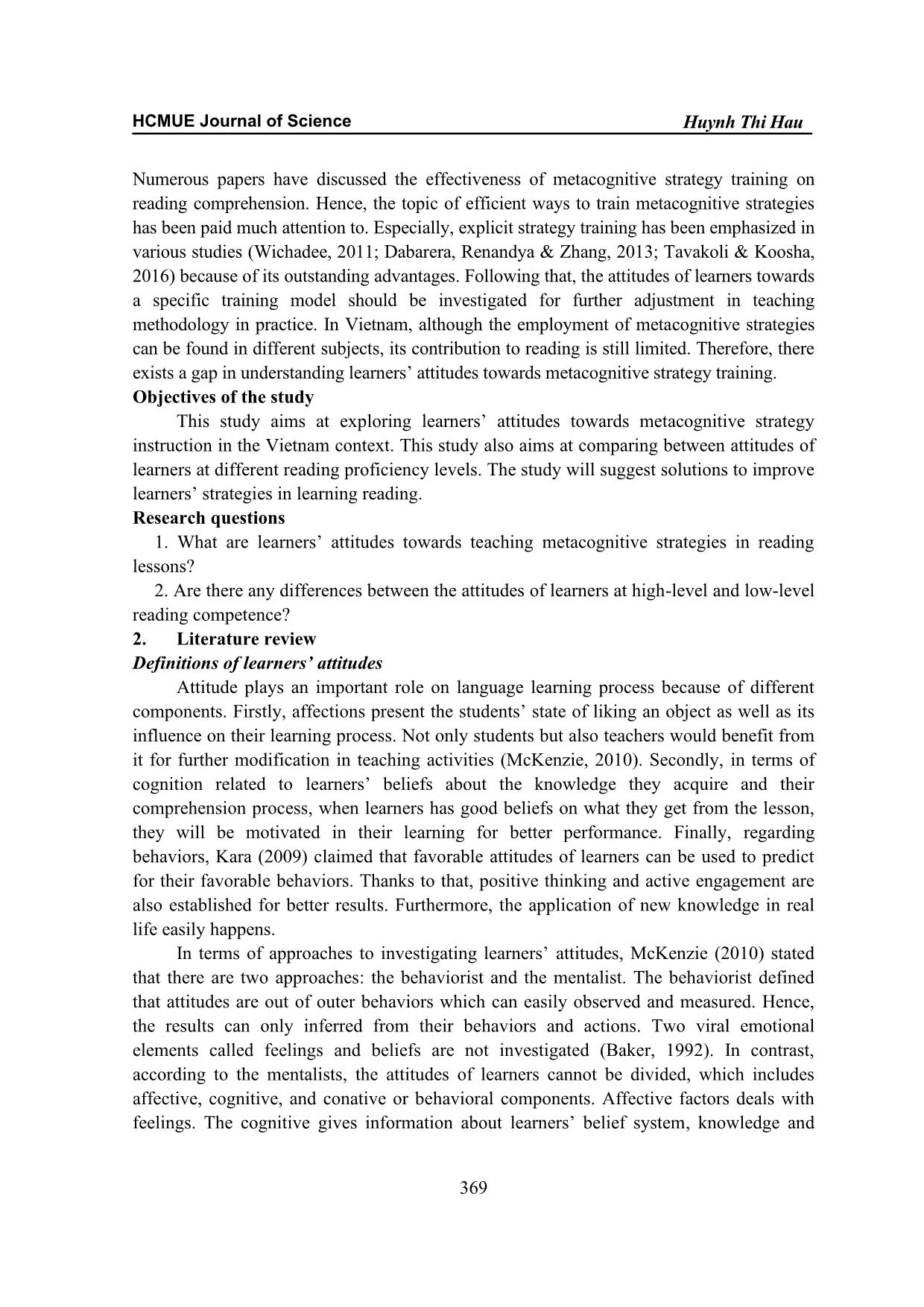
Trang 2
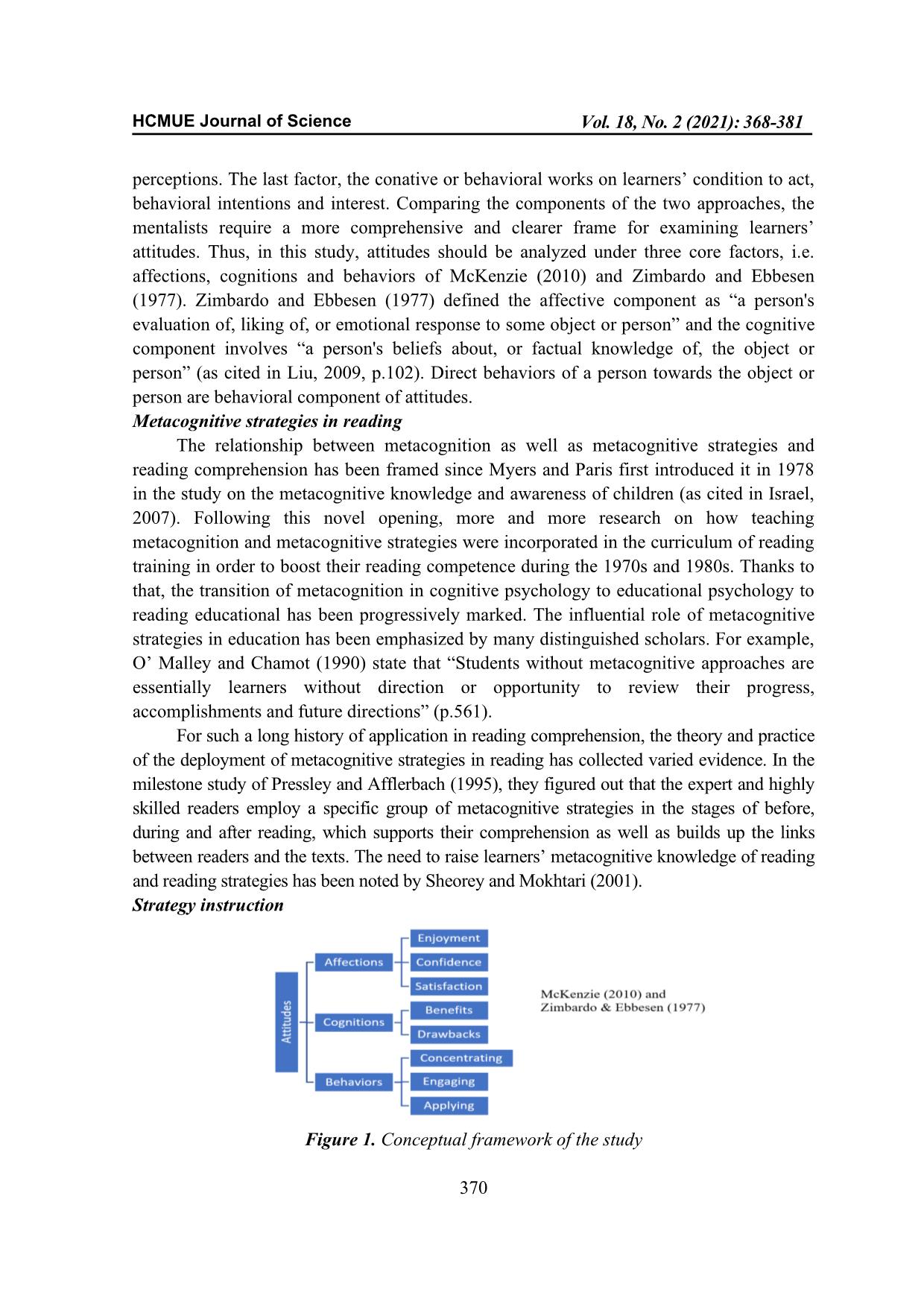
Trang 3
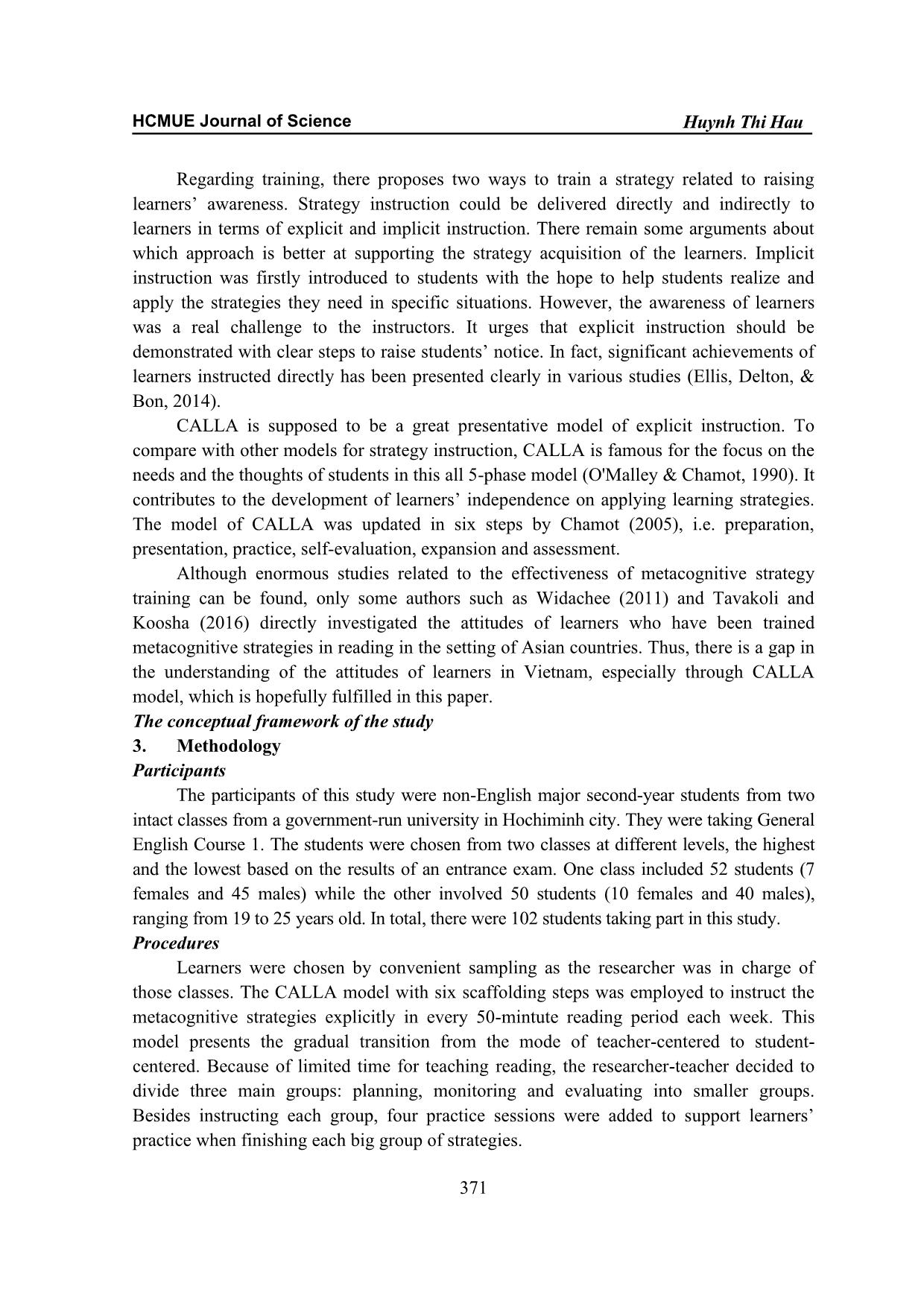
Trang 4
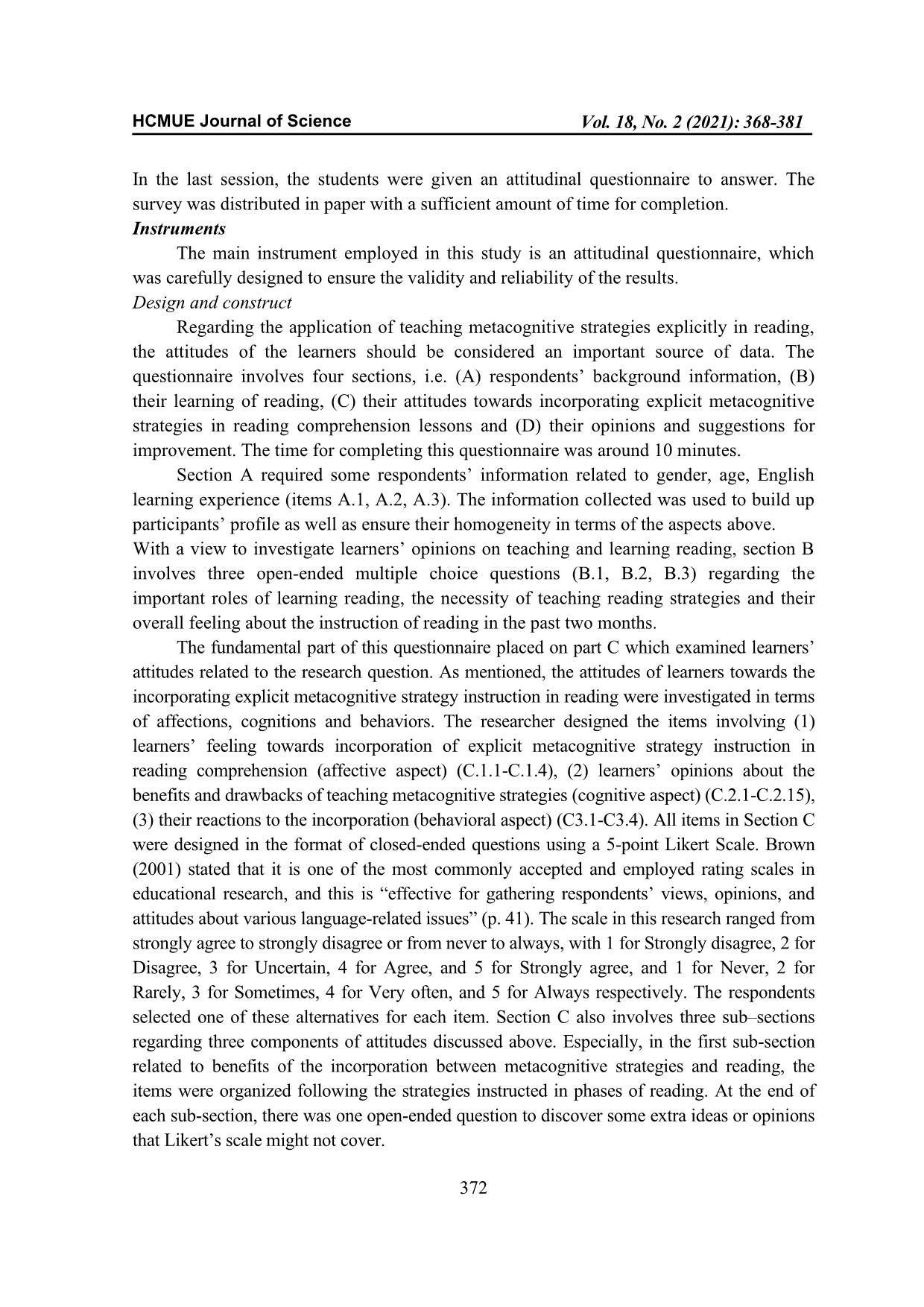
Trang 5
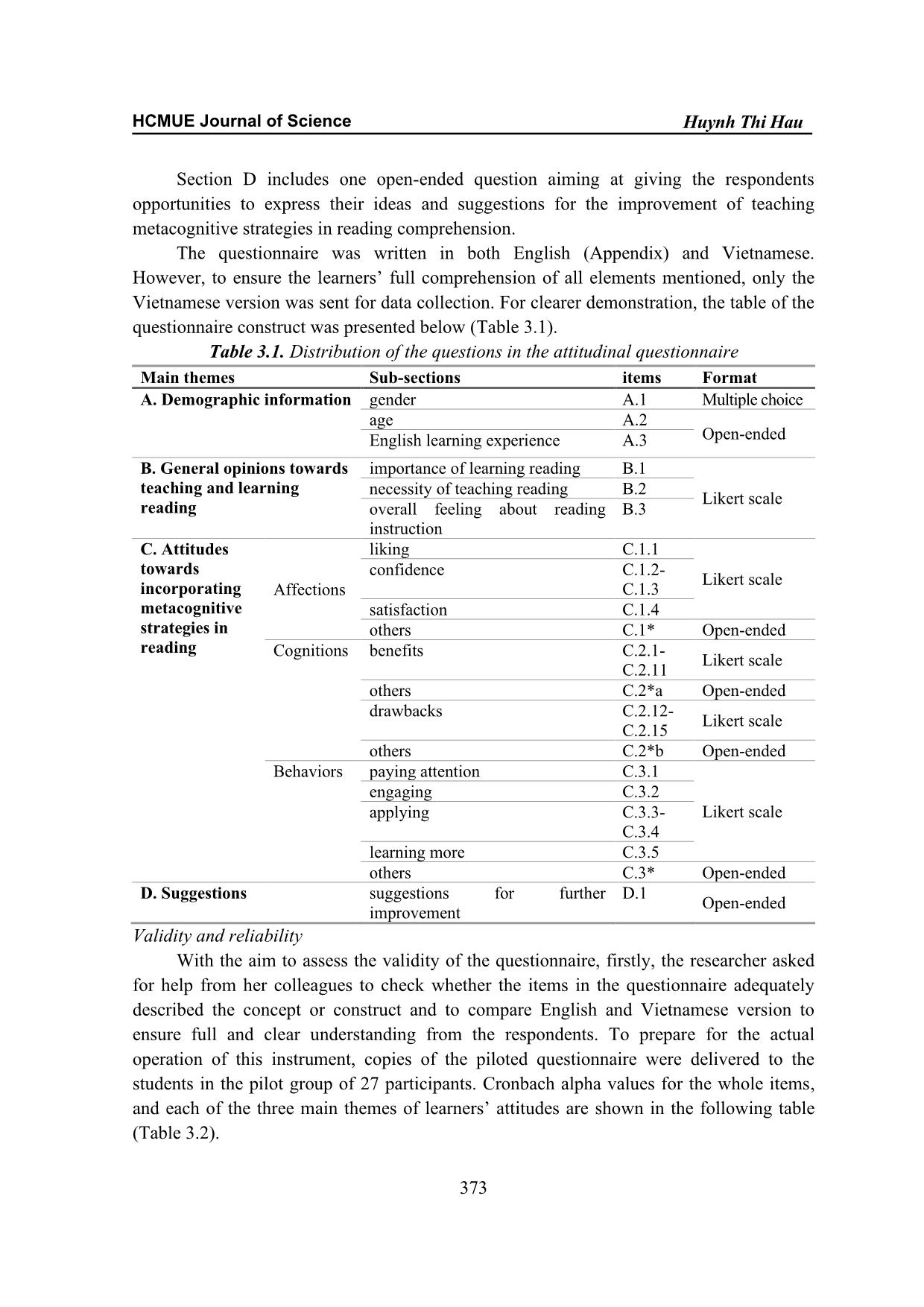
Trang 6
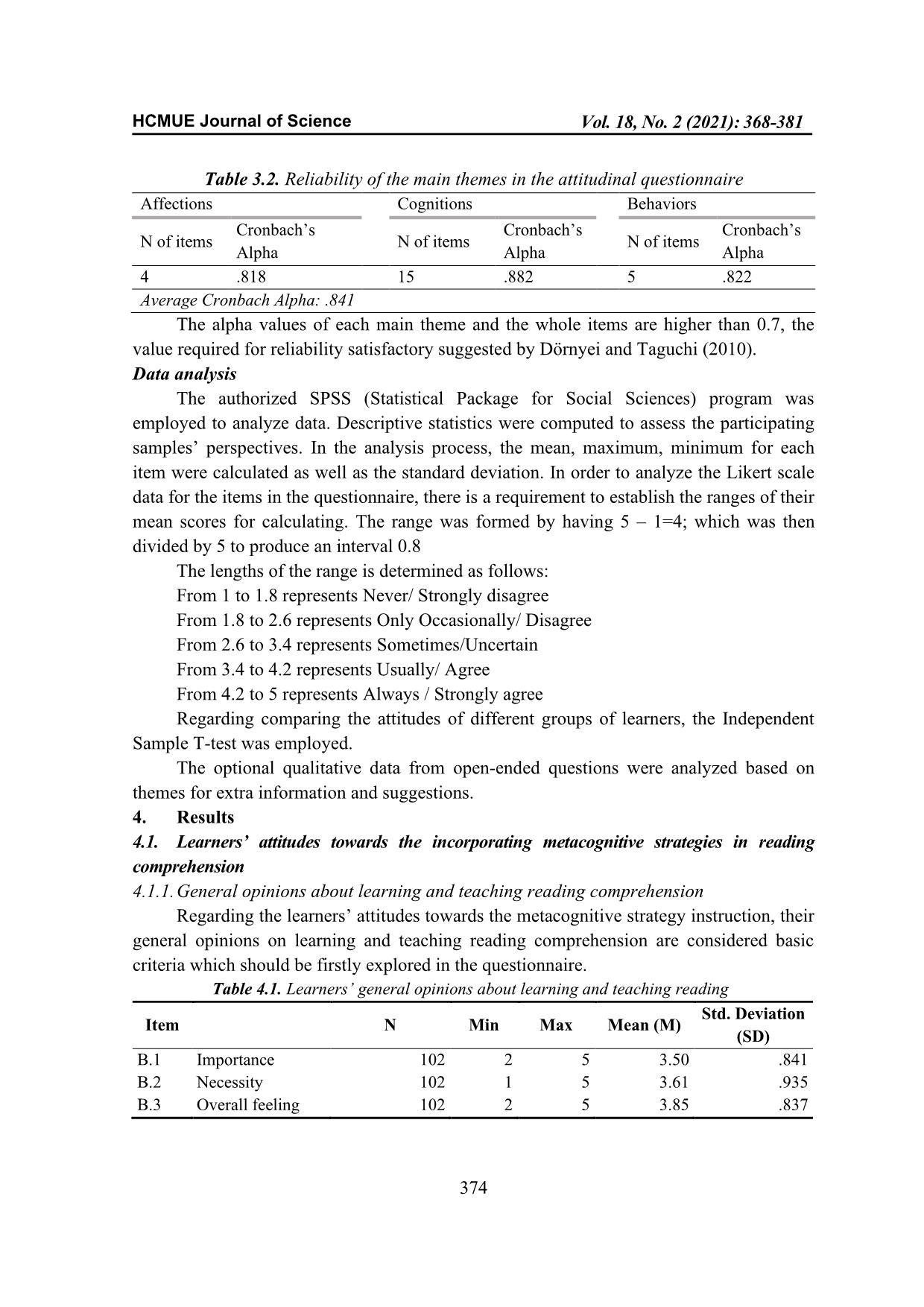
Trang 7
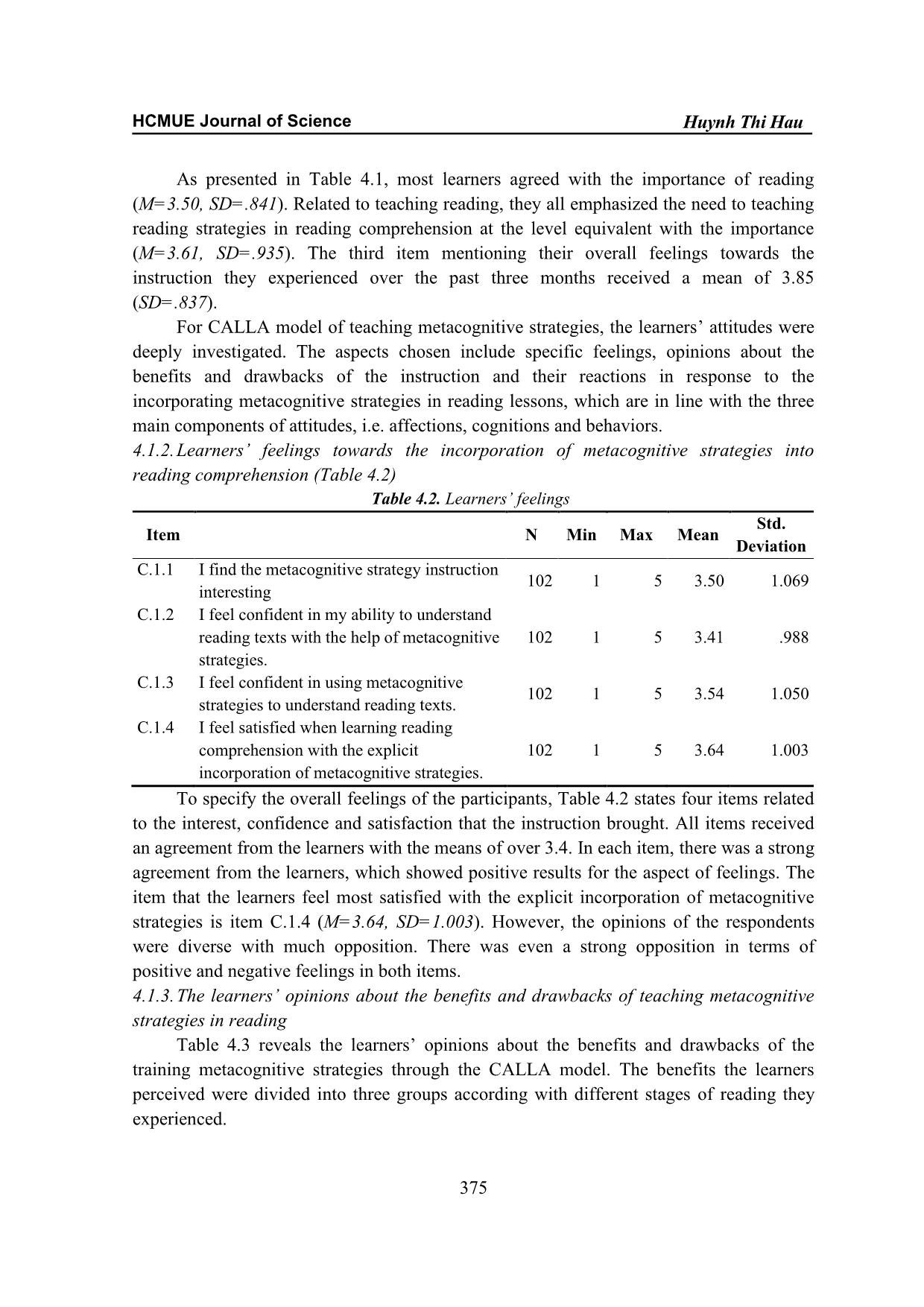
Trang 8
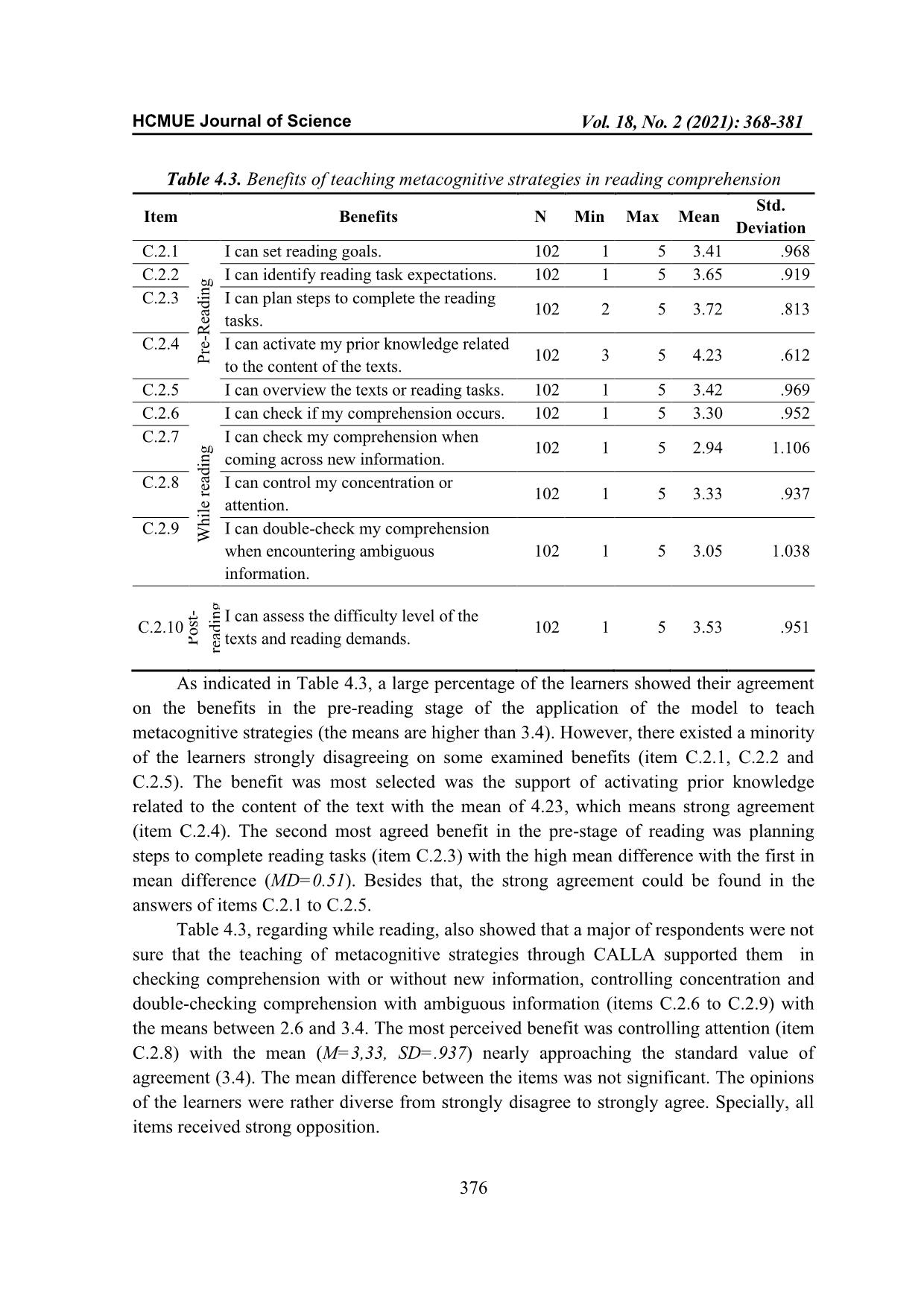
Trang 9
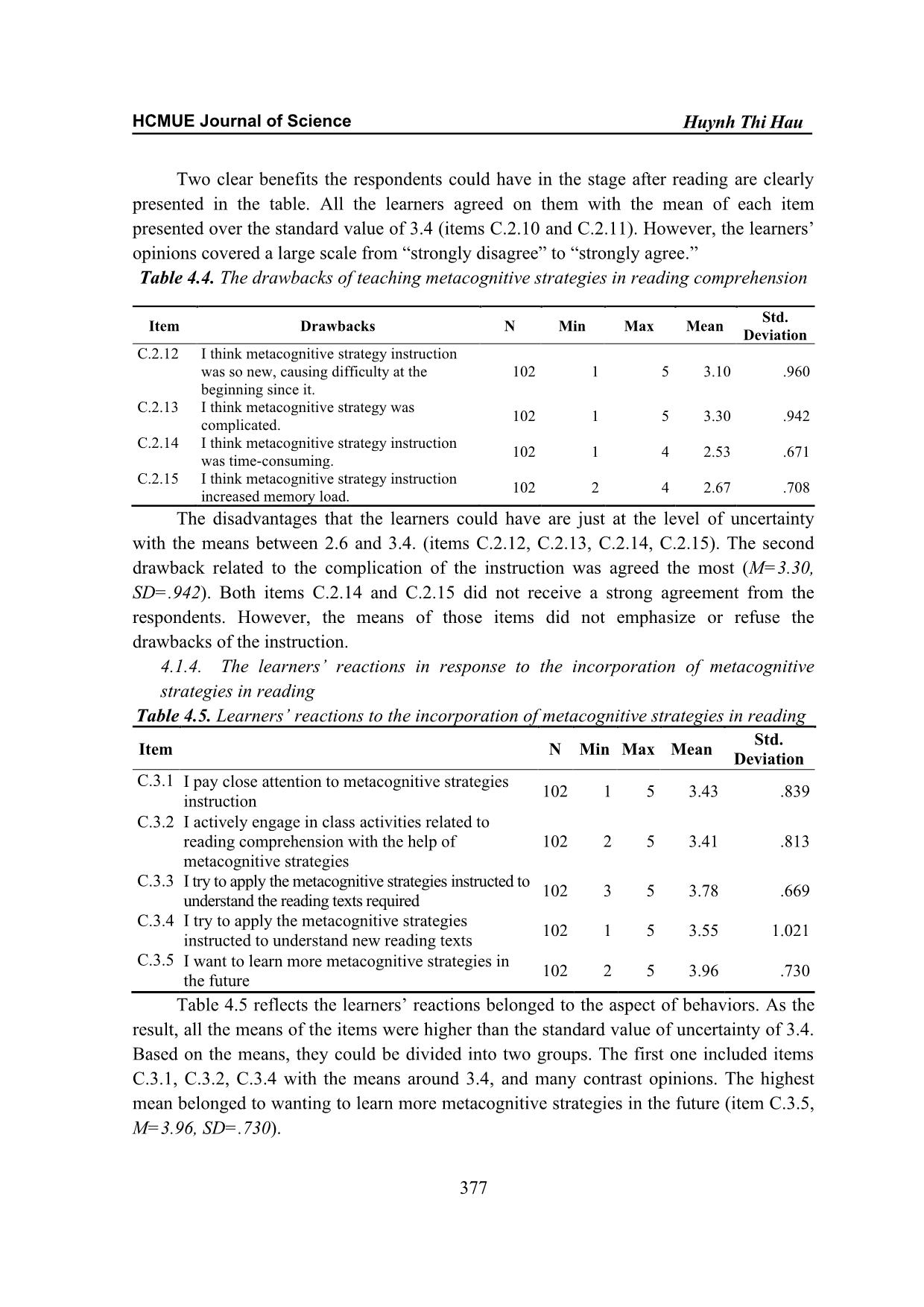
Trang 10
Tải về để xem bản đầy đủ
Tóm tắt nội dung tài liệu: An investigation into learners’ attitudes towards training metacognitive strategies in reading comprehension
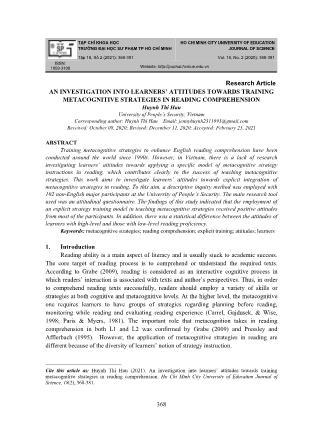
scale from “strongly disagree” to “strongly agree.” Table 4.4. The drawbacks of teaching metacognitive strategies in reading comprehension The disadvantages that the learners could have are just at the level of uncertainty with the means between 2.6 and 3.4. (items C.2.12, C.2.13, C.2.14, C.2.15). The second drawback related to the complication of the instruction was agreed the most (M=3.30, SD=.942). Both items C.2.14 and C.2.15 did not receive a strong agreement from the respondents. However, the means of those items did not emphasize or refuse the drawbacks of the instruction. 4.1.4. The learners’ reactions in response to the incorporation of metacognitive strategies in reading Table 4.5. Learners’ reactions to the incorporation of metacognitive strategies in reading Item N Min Max Mean Std. Deviation C.3.1 I pay close attention to metacognitive strategies instruction 102 1 5 3.43 .839 C.3.2 I actively engage in class activities related to reading comprehension with the help of metacognitive strategies 102 2 5 3.41 .813 C.3.3 I try to apply the metacognitive strategies instructed to understand the reading texts required 102 3 5 3.78 .669 C.3.4 I try to apply the metacognitive strategies instructed to understand new reading texts 102 1 5 3.55 1.021 C.3.5 I want to learn more metacognitive strategies in the future 102 2 5 3.96 .730 Table 4.5 reflects the learners’ reactions belonged to the aspect of behaviors. As the result, all the means of the items were higher than the standard value of uncertainty of 3.4. Based on the means, they could be divided into two groups. The first one included items C.3.1, C.3.2, C.3.4 with the means around 3.4, and many contrast opinions. The highest mean belonged to wanting to learn more metacognitive strategies in the future (item C.3.5, M=3.96, SD=.730). Item Drawbacks N Min Max Mean Std. Deviation C.2.12 I think metacognitive strategy instruction was so new, causing difficulty at the beginning since it. 102 1 5 3.10 .960 C.2.13 I think metacognitive strategy was complicated. 102 1 5 3.30 .942 C.2.14 I think metacognitive strategy instruction was time-consuming. 102 1 4 2.53 .671 C.2.15 I think metacognitive strategy instruction increased memory load. 102 2 4 2.67 .708 HCMUE Journal of Science Vol. 18, No. 2 (2021): 368-381 378 4.2. The difference of the attitudes of high-level and low level learners To investigate whether the difference in the attitudes of learners in low-level and high-level groups is significant, an Independent-sample T-test was conducted. The results is shown in Table 4.6. Table 4.6. Independent Sample T-test of different groups of learners Low-level (n=52) High level (n=50) t(102) p 95%CI M SD M SD LL UL Affections 3.0 1.03 3.99 .72 -5.23 .000 -1.272 -.574 Cognitions 3.08 .79 3.58 .65 -3.54 .000 -.79 -.22 Behaviors 3.38 .61 3.88 .47 -4.62 .001 -.709 -.282 According to Table 4.6, the sig. value of the Levene’s test of the affections group was lower than .05 (sig.=0.09), which allows us to assume the equal variances of it. However, the sig. values of the Levene’s test were respectively higher than .05, which led to the unequal variances assumption in cognition and behaviors. For the affections, there was a significant difference in the means of the low-level (M=3.07, SD=1.03) comparing to the high-level (M=3.99, SD=.716) with the two-tailed sig. value lower than the standard value (p=.000<.05). The mean difference of this group was identified the most significant one among the three factors. Similarly, in terms of cognitions and behaviors, the mean difference of the low-level and high-level was significant (p<.05). The values of the mean difference of the two factors above were about .05. To sum up, there was a significant difference between the attitudes of the low-level and high-level regarding the three factors, i.e. affections, cognitions and behaviors. 5. Discussions The first research question seeks to investigate the attitudes of learners towards the metacognitive strategy instruction incorporated in reading lessons. The attitudes were evaluated in three components, i.e. affections, cognitions and behaviors. The statistics generally revealed that all the learners were aware of the importance of reading in their English learning. The equivalent percentage of respondents confirming the statement above agreed on the instruction of reading strategies to support reading learning. The participants mostly gave positive feelings towards the instruction they experienced, which lends support to previous research by Wichadee (2011) and Tavakoli and Koosha (2016). Firstly, in terms of affections, the results figure out the agreement on the interest, confidence and satisfaction the participants got from the instruction. In fact, not all the learners found the reading instruction interesting. Some opinions even stated that the instruction was boring and not appropriate with their learning with lots of tasks. The same negative opinions above can be found in the study of Wichadee (2011) from the group of low-proficiency in reading. Besides that, a large percentage of learners feel more confident in understanding texts with the support of metacognitive strategies as well as using strategies trained, which can be explained due to the reasonable training duration for the participants to get familiar with strategies taught. Most importantly, they were satisfied HCMUE Journal of Science Huynh Thi Hau 379 with the instruction, which is a profound base for deeper awareness of participants in the second factor, cognitions. Benefits and drawbacks were reflected clearly according to the data collected. The leaners mostly agreed on the benefits of the instruction. They were used to applying the strategies trained, which is in the support of the findings by Tavakoli and Koosha (2016). In the study, they found that the students’ self-efficacy improved significantly as a consequence of the strategy instruction. The favorite benefit noted was activating prior knowledge with a strong agreement. It can be explained that this strategy is simple and very practical for most learners to get familiar with metacognitive strategies. The next one, planning steps for reading, was highly recommended for its implications. However, the learners were uncertain to get benefits from the strategies in while-reading stage such as checking comprehension with or without new information, controlling concentration and double-checking comprehension with ambiguous information. They were likely to have some problems with the strategies related controlling comprehension. Most benefits all received a strong disagreement from the participants. It means there are some learners in a need of help to understand and get benefits form the strategies instructed. It was also reflected in the suggestions for clearer practical application sections. Regarding disadvantages, the learners were uncertain about the disadvantages of the instruction. The most reported issue was related to the difficult feelings at first of the instruction. It can be from the instructor and materials. In the qualitative data, it was suggested that the instructor should use reading texts with familiar topics first. In the third factor of behaviors, the learners largely agreed on paying close attention, actively engaging, applying texts required, applying new texts and expecting to learn more. The most expected reactions were wanting to learn more metacognitive strategies and applying those strategies to understand texts. This reflects the practical application of metacognitive strategies. However, the findings also show some negative feedback from the respondents, which can be analyzed deeply in the second research question related to the different attitudes of learners regarding their language proficiency. In the analysis of different attitudes of the learners at the high-level and low-level reading competence, the findings from the Independent Sample T-test was employed. The result showed that although both groups were aware of the importance of learning reading and teaching reading strategies to support learning. The high-level group had more positive feelings towards the instruction, which is consistent with the findings by Wichadee (2011), Zhang (2009) and Schunk and Zimmerman (1998). Particularly, the low-level and high-level, according to the statistics tests, were different in terms of all three aspects, i.e. affections, cognitions and behaviors. The difficulties the low-level group facing could be found in the qualitative data: the instruction is inappropriate, boring and abstract for application. In contrast, the high-level felt more confident with learning strategies. Despite the amount of time taken to follow the instruction, the high-level learners found it worth learning. HCMUE Journal of Science Vol. 18, No. 2 (2021): 368-381 380 6. Conclusions and implications The findings of the study reflected two main points. Firstly, the learners generally have positive attitudes towards the metacognitive strategy instruction incorporated in reading lessons through the CALLA model. However, the participants have some problems with the strategies related to controlling comprehension. Secondly, there are some differences in terms of affections, cognitions and behaviors between the low-level and high-level groups of learners in response to the metacognitive strategy instruction. The findings of the present study have implications for both teachers and learners. For teachers, it is recommended that metacognitive strategy instruction should be considered and modified to be more appropriate with the learners. Strategies need to be taught over a sufficient duration to be effective and should be presented over a number of contexts with a variety of texts to make sure that the learners will be able to use the strategies automatically. Moreover, teachers should have some deeper investigations into the learners’ favors and difficulties they are encountering. For learners, they should be get familiar with planning and self-evaluating steps in applying metacognitive strategies trained, which promotes metacognitive strategy application. ❖ Conflict of Interest: Author has no conflict of interest to declare. REFERENCES Baker, C. (1992). Attitude and language. Clevedon: Mutilingual Matters. Carrell, P., Gajdusek, L. and Wise, T. (1998). Metacognition and EFL/ESL reading. Instructional Science, 26, 97–112. Chamot, A. (2005). Language learning strategy instruction: Current issues and research. Annual review of Applied Linguistics, 25, 112-130. Dabarera, C., Renandya, W.A., & Zhang, L. J. (2014). The impact of metacognitive scaffolding and monitoring on reading comprehension. System: An International Journal of Educational Technolog and Applied Linguistics, 42, 462-473. Dörnyei, Z., & Taguchi, T. (2010). Questionnaires in second language research: Construction, administration and processing (2nd ed.). London: Routledge. Ellis, A., Delton, D. & Bond, J. (2014). An analysis of research on metacognitive teaching strategies. Procedia - Social and Behavioral Sciences, 116, 4015 – 4024. Grabe, W. (2009). Reading in a second language: Moving from theory to practice. Cambridge: Cambridge Press. Israel, S. E. (2007). Using Metacognitive Assessments to Create Individualized Reading Instruction. Newark, DE: International Reading Association. Kara, A. (2009). The effect of a "Learning Theories" Unit on students' attitudes towards learning. Australian Journal of Teacher Education, 34(3), 100-113. HCMUE Journal of Science Huynh Thi Hau 381 Liu, J. (2009). A survey of EFL learners' attitudes toward information and communication technologies. English Langugae teching, 2(2), 101-106. McKenzie, R. M. (2010). The Social Psychology of English as a Global Language: Attitudes, Awareness and Identity in the Japanese Context. Dordrecht: Springer. O'Malley J. M., & Chamot A. U. (1990). Learning strategies in second language acquisition. Cambridge: Cambridge University Press. Paris, S. G., & Myers, M. (1981). Comprehension monitoring, memory, and study strategies of good and poor readers. Journal of Reading Behavior, 13(1), 5–22. Pressley, M., & Afflerbach, P. (1995). Verbal protocols of reading: The nature of constructively responsive reading. Hillsdale, NJ: Erlbaum. Schunk, D. H., & Zimmerrman, B. J. (1998). Self-regulated learning: From teaching. NY, New York: Guilford Press. Sheorey, R., & Mokhtari, K. (2001). Differences in the metacognitive awareness of reading strategies among native and nonnative readers. System, 29, 421-449. Tavakoli, H., & Koosha, M.,. (2016). The effect of explicit metacognitive strategy instruction on reading comprehension. PortaLinguarum, 25, 119-133. Wichadee, S. (2011). The effects of metacognitive strategy instruction on Thai students' reading comprehension ability. Journal of College Teaching & Learning (TLC), 8(5), 31-40. doi:https://doi.org/10.19030/tlc.v8i5.4255 Zhang, L. J. (2008). Constructivist pedagogy in strategic reading instruction: Exploring pathways to learner. Instructional Science, 36, 89-116. NGHIÊN CỨU THÁI ĐỘ CỦA NGƯỜI HỌC ĐỐI VỚI VIỆC GIẢNG DẠY CÁC CHIẾN LƯỢC SIÊU NHẬN THỨC TRONG ĐỌC HIỂU Huỳnh Thị Hậu Trường Đại học An ninh nhân dân, Việt Nam Tác giả liên hệ: Huỳnh Thị Hậu – Email: jennyhuynh2311993@gmail.com Ngày nhận bài: 08-10-2020; ngày nhận bài sửa: 11-12-2020; ngày duyệt đăng: 25-02-2021 TÓM TẮT Việc giảng dạy các chiến lược siêu nhận thức nhằm nâng cao kĩ năng đọc hiểu tiếng Anh đã được tiến hành trên thế giới từ thập niên 90 của thế kỉ XX. Ở Việt Nam, những nghiên cứu về thái độ của người học đối với một mô hình cụ thể giảng dạy các chiến lược siêu nhận thức trong dạy đọc vẫn còn hạn chế. Nghiên cứu thái độ của người học góp phần vào thành công của việc giảng dạy các chiến lược siêu nhận thức. Công trình nghiên cứu này nhằm tìm hiểu thái độ của người học đối với việc kết hợp giảng dạy trực tiếp các chiến lược siêu nhận thức trong dạy đọc. Theo đó, phương pháp nghiên cứu mô tả theo hướng định lượng đã được áp dụng trên 102 học viên không chuyên Anh tại Trường Đại học An ninh nhân dân. Công cụ chính của công trình này là bảng khảo sát đã được kiểm tra độ tin cậy và độ chính xác. Kết quả nghiên cứu cho thấy việc vận dụng mô hình giảng dạy trực tiếp trong dạy chiến lược siêu nhận thức nhận được ý kiến tích cực từ người học; trong đó, có sự khác biệt về thái độ giữa nhóm người học có trình độ đọc thấp và cao. Từ khóa: chiến lược siêu nhận thức; đọc hiểu; giảng dạy trực tiếp; thái độ; người học
File đính kèm:
 an_investigation_into_learners_attitudes_towards_training_me.pdf
an_investigation_into_learners_attitudes_towards_training_me.pdf

